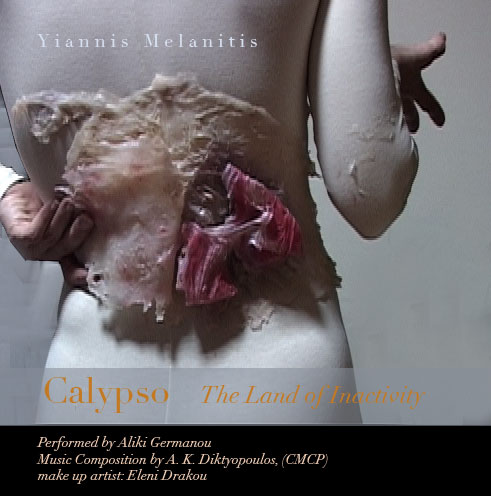
Yiannis Melanitis
...-Sweet almond oil and tincture of benzoin, Mr Bloom said, and then
orangeflower water ....
It certainly did make her skin so delicate white like wax.
¯ And white wax also, he said.
Brings out the darkness of her eyes. Looking at me, the sheet up to
her eyes, Spanish, smelling herself, when I was fixing the links in my cuffs.
Those homely recipes are often the best: strawberries for the teeth: nettles
and rainwater: oatmeal they say steeped in buttermilk. Skinfood. One of
the old queen's sons, duke of Albany was it? had only one skin. Leopold,
yes. Three we have. Warts, bunions and pimples to make it worse...
James Joyce, Ulysses, chapter 5-in correspondance to the homerc text, The Lotus Eaters
The Land of Noman [part 3]
Calypso- Land of Inactivity
The pre-civilized island Ogygia[2] represents a place of pathological inactivity, a place of the fantastic, an exotic island belonging to the land of
geographic imagination.[Calypso- Land of Inactivity is part of the work The Land of Noman, work in five acts, with their correspondances:
Calypso, Nausicaa, Circa, Penelope- the fifth act refers to the residency of Ulysses as Faust in Ithaca.The work consists of five parts each one
interconnected to the Homeric narration through Ulysses novel by James Joyce. It refers to the transformations of a female persona which
represents the four different societies visited by Ulysses. Four islands, four societies, four women, four environments of distinct techniques,
represented by female performers in bodily transformations. At the Dermatograhies exhibition, Calypso is depicted as a representation of
inactivity in an exotic place, where the reception of Ulysses is transformed to captivity.
The performer¢s actions refer to the correspondences of Joyce in the work Ulysses. Materials:Silicone, gold, natrium.
The labyrinthine Ulysses of James
Joyce, consists of a multi-layered text where facts seem to proceed in time
overlaps, although the action takes
place in 18 chapters, spaced approximately
one hour apart from each other, starting at 8:00am on Thursday 16 June 1904,
and ending in the early
hours of June 17. Joyce produced a schema for the novel
Ulysses to help his friend Carlo Linati understand the structure of the book:
enormous bulk and the more than enormous complexity of my damned monster-novel
it would be better to send him a sort of summary - key - skeleton - scheme (for
home use only)...I have
given only "Schlagworte" [catchwords] in my
scheme but I think you will understand it all the same. It is the epic of two
races (Israel-Ireland) and at the same time the cycle of the human
body as well
as a little story of a day (life). The character of Ulysses has fascinated me
ever since boyhood. ?For seven years I have been working at this book - blast
it! It is also a kind
of encyclopaedia. My intention is not only to render the
myth sub specie temporis nostri [in the light of our own times] but also to
allow each adventure (that is, every hour, every organ,
every art being
interconnected and interrelated in the somatic scheme of the whole) to
condition and even to create its own technique. Each adventure is so to speak
one person although
it is composed of persons - as Aquinas relates of the
heavenly hosts.
Calypso, The Land of Ogygia
Scene: The House
Hour: 8 am
Organ: Kidney
Art: Economics
Colour: Orange
Symbol: Nymph
Technic: Narrative (mature)
Correspondences: Calypso - The Nymph; Dlugacz: The Recall; Zion - Ithaca
Meaning:The departing wayfarer
Homeric correspondences: inactivity, pathological situation, place of the fantastic.2. Ogygia and Skheria are mentioned as phantom islands.
Phantom islands are islands that are believed to exist and appear on maps for a period of time (sometimes centuries), and then are removed after they are proven not to exist (or the general
population stops believing that they exist).
Concept: Yiannis Melanitis
Performed by Aliki Germanou
Music Composition by A. Diktyopoulos, (CMCP-Centre for Music Composition and Performance)
make up artist: Eleni Drakou